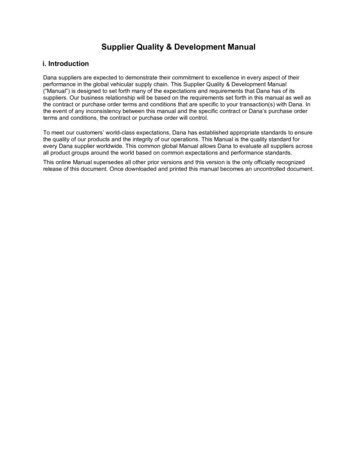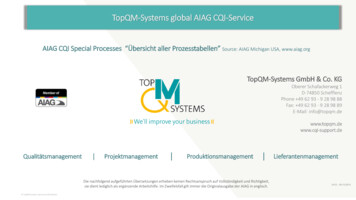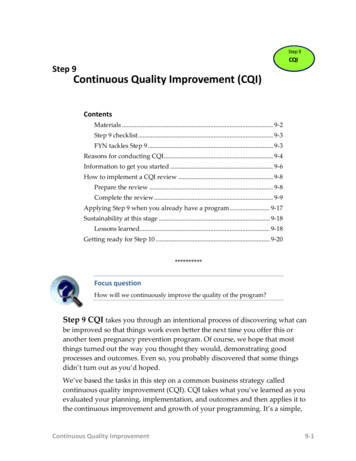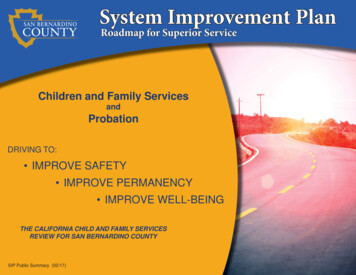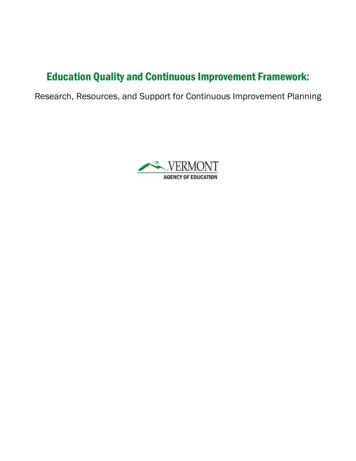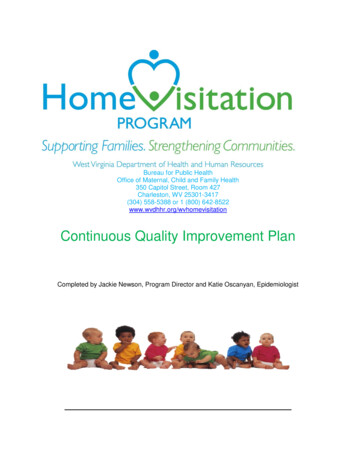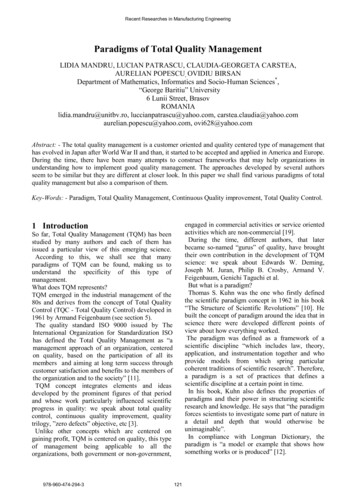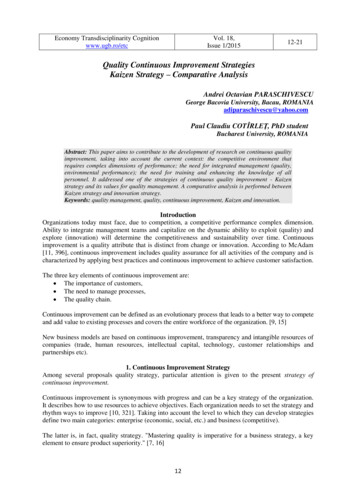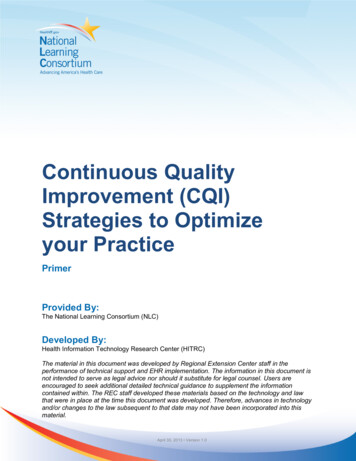
Transcription
Continuous QualityImprovement (CQI)Strategies to Optimizeyour PracticePrimerProvided By:The National Learning Consortium (NLC)Developed By:Health Information Technology Research Center (HITRC)The material in this document was developed by Regional Extension Center staff in theperformance of technical support and EHR implementation. The information in this document isnot intended to serve as legal advice nor should it substitute for legal counsel. Users areencouraged to seek additional detailed technical guidance to supplement the informationcontained within. The REC staff developed these materials based on the technology and lawthat were in place at the time this document was developed. Therefore, advances in technologyand/or changes to the law subsequent to that date may not have been incorporated into thismaterial.April 30, 2013 Version 1.0
1234The EHR Implementation LifecycleStep 6: Continue Quality Improvement56NATIONAL LEARNING CONSORTIUMThe National Learning Consortium (NLC) is a virtual and evolving body of knowledge and resourcesdesigned to support health care providers and health IT professionals working toward the implementation,adoption, and Meaningful Use of certified electronic health record (EHR) systems.The NLC represents the collective EHR implementation experiences and knowledge gained directly fromthe field of ONC’s outreach programs (REC, Beacon, State HIE) and through the Health InformationTechnology Research Center (HITRC) Communities of Practice (CoPs).The following resource can be used in support of the EHR Implementation Lifecycle. It is recommendedby “boots-on-the-ground” professionals for use by others who have made the commitment to implementor upgrade to certified EHR systems.EHR Implementation LifecycleDESCRIPTION AND INSTRUCTIONSContinuous Quality Improvement (CQI) is a quality management process that encourages all health careteam members to continuously ask the questions, “How are we doing?” and “Can we do it better?”(Edwards, 2008). To address these questions, a practice needs structured clinical and administrativedata. EHRs can, if properly designed and implemented, capture these data efficiently and effectively,thereby transforming patient care in ways that might have been difficult or impossible with paper recordsalone.This Primer introduces CQI concepts, strategies, and techniques a practice can use to design an effectiveCQI strategy for EHR implementation, achieve Meaningful Use of the system, and ultimately improve thequality and safety of patient care. A practice can use CQI throughout the EHR implementation lifecycle.CQI strategies have been successfully implemented in many industries, including health care. The CQIconceptual framework presented in this Primer provides a foundation to design and manage CQIinitiatives and offers points to consider when deciding which strategy works best for a particular practiceor organization. A CQI toolkit, currently under development, will elaborate in more detail the conceptsprovided in this Primer.Section 1 of this Primer defines CQI and its relationship to Meaningful Use and EHR implementation andpresents a case study of CQI concepts. Section 2 describes the leading strategies to be considered whendesigning a CQI program for a practice. Section 3 provides guidance for planning a CQI initiative andselecting a CQI strategy that matches the needs of various practice settings.April 30, 2013 Version 1.0i
1234The EHR Implementation LifecycleStep 6: Continue Quality Improvement56TABLE OF CONTENTS1Continuous Quality Improvement (CQI) in the EHR Implementation Lifecycle . 11.1 Introduction . 11.2 What Is Continuous Quality Improvement? . 11.3 How Can CQI Help a Practice Make the most OF Meaningful Use? . 21.4 What Does CQI Look Like in Practice? . 42Strategies for CQI . 62.1 Leading CQI Strategies in Health care . 62.1.1 The Institute for Healthcare Improvement (IHI) Model for Improvement . 62.1.2 Lean . 72.1.3 Six Sigma . 102.1.4 Baldrige Quality Award Criteria . 122.2 Which CQI Strategy Is Right? . 142.3 Best Practices to Consider in Using a CQI Strategy . 152.3.1 Have the Right Data and Use the Data Well . 152.3.2 Have the Resources to Finish the Job . 16LIST OF EXHIBITSExhibit 1. Using CQI to Move From Current State to Future State . 3Exhibit 2. CQI Framework Model . 4Exhibit 3. IHI Model for Improvement . 6Exhibit 4. Lean Principles for Operational Efficiency . 8Exhibit 5. Six Sigma Model . 10Exhibit 6. Baldrige Core Values and Concepts . 12Exhibit 7. Summary of Leading Strategies for CQI . 14April 30, 2013 Version 1.0ii
12345The EHR Implementation LifecycleStep 6: Continue Quality Improvement61 Continuous Quality Improvement (CQI) in theEHR Implementation Lifecycle i1.1INTRODUCTIONThe quest to use health information technology (IT), specifically EHRs, to improve the quality of health carethroughout the health care delivery continuum is a consistent goal of health care providers, national and localpolicymakers, and health IT developers. The seminal Institute of Medicine (IOM) report, Crossing the QualitystChasm: A New Health System for the 21 Century (IOM, 2001), was a call for all health care organizationsto renew their focus on improving the quality and safety of patient care in all health care delivery settings.Since the IOM report, the health care industry has emphasized the design and implementation of health ITthat supports quality improvement (QI) and quality monitoring mechanisms in all levels of the health caredelivery system. Many QI strategies currently used in health care, including Continuous Quality Improvement(CQI), have been adopted from other industries that have effectively used QI techniques to improve theefficiency and quality of their goods and services. Experience and research have shown that CQI principles,strategies, and techniques are critical drivers of new care models such as Patient-Centered Medical Homes(PCMHs) or Accountable Care Organizations (ACOs). As practice leaders and staff learn more about CQIstrategies and identify what works best for the desired type and level of changes in the practice setting (i.e.,moving from the current state to the desired future state), they will recognize the value in designing an EHRimplementation to meet both the Meaningful Use requirements and their own QI goals.This Primer provides an overview of CQI concepts and processes and will: 1.2Define CQI and how it applies to EHR implementations and practice improvement strategies;Identify a conceptual framework to consider when implementing CQI techniques in a practice setting;Explore tools, techniques, and strategies that health care and other service industries use to guide andmanage CQI initiatives;Guide the selection of the most appropriate CQI technique or strategy for the type and scale ofimprovements the practice is considering; and,Provide tips to help the practice leaders tailor the approach, tools, methods, and processes to theunique CQI initiative and practice setting.WHAT IS CONTINUOUS QUALITY IMPROVEMENT?Put simply, CQI is a philosophy that encourages all health care team members to continuously ask: “How arewe doing?” and “Can we do it better?”(Edwards, 2008). More specifically, can we do it more efficiently? Canwe be more effective? Can we do it faster? Can we do it in a more timely way? Continuous improvementbegins with the culture of improvement for the patient, the practice, and the population in general.Besides creating this inquisitive CQI culture in an organization, the key to any CQI initiative is using astructured planning approach to evaluate the current practice processes and improve systems andprocesses to achieve the desired outcome and vision for the desired future state. Tools commonly used inCQI include strategies that enable team members to assess and improve health care delivery and services.Applying CQI to a practice’s EHR implementation means that the health care team must understand whatworks and what does not work in the current state and how the EHR will change care delivery and QI aims.The CQI plan identifies the desired clinical or administrative outcome and the evaluation strategies thatenable the team to determine if they are achieving that outcome. The team also intervenes, when needed, toadjust the CQI plan based on continuous monitoring of progress through an adaptive, real-time feedbackloop.April 30, 2013 Version 1.01
1234The EHR Implementation LifecycleStep 6: Continue Quality Improvement1.356HOW CAN CQI HELP A PRACTICE MAKE THE MOST OF MEANINGFULUSE?Meaningful Use is an important means to achieving the triple aims of health care—improving the experienceof patient care, improving population health, and reducing per capita costs of health care (Berwick et al.,2008). The Centers for Medicare and Medicaid Services’ EHR Incentive Program provides eligibleprofessionals, eligible hospitals, and critical access hospitals incentive payments that support the optimal useof technology for health care (Incentive Programs—Regulations and Guidance). Although a practice canimplement an EHR without addressing Meaningful Use, practices that do so are less likely to realize the fullpotential of EHRs to improve patient care and practice operations (Mostashari, Tripathi, & Kendall, 2009).Attesting to Meaningful Use, although it is an important milestone for a practice, is not an end unto itself.Practices that can achieve Meaningful Use will be able to use their EHR to obtain a deep understanding oftheir patient population and uncover aspects of patient care that could be improved. Using a planned,strategic approach to CQI will help a practice move from reporting the requirements for Meaningful Use toimproving patient care and meeting other practice goals. The literature shows a strong link between anexplicit CQI strategy and high performance (Shortell et al., 2009). Thus, applying CQI principles andstrategies will transform numbers on a spreadsheet or a report into a plan for action that identifies areas offocus and the steps and processes needed to improve those areas continually and iteratively.To establish an effective CQI strategy, a practice should (Wagner et al., 2012) Choose and use a formal model for QI.Establish and monitor metrics to evaluate improvement efforts and outcomes routinely.Ensure all staff members understand the metrics for success.Ensure that patients, families, providers, and care team members are involved in QI activities.Optimize use of an EHR and health IT to meet Meaningful Use criteria.Put together, CQI and Meaningful Use can move a practice from its current state to a more desirable futurestate. As depicted in Exhibit 1, CQI begins with a clear vision of the transformed environment, identificationof necessary changes to achieve that vision, and input from engaged team members who understand theneeds for the practice. In short, the journey to the desired future state involves a transformation of people,process, and technology. Meaningful Use of health information and an explicit commitment to CQI can help apractice establish that clear vision and implement it successfully.April 30, 2013 Version 1.02
12345The EHR Implementation LifecycleStep 6: Continue Quality Improvement6Exhibit 1. Using CQI to Move From Current State to Future StateApril 30, 2013 Version 1.03
1234The EHR Implementation LifecycleStep 6: Continue Quality Improvement1.456WHAT DOES CQI LOOK LIKE IN PRACTICE?In undertaking any CQI initiative, a practice must consider three components: (1) structure, (2) process, and(3) outcomes (Donabedian, 1980). Exhibit 2 builds on these three components within the context of healthinformation technology and illustrates the basic premise of CQI: any initiative involving an EHR to improvepatient care must focus on the structure (especially technology and people) and process that lead to theexpected outputs and then ultimately to the desired outcomes.Exhibit 2. CQI Framework ModelStructure. Structure includes the technological, human, physical, and financial assets a practice possessesto carry out its work. CQI examines the characteristics (e.g., number, mix, location, quality, and adequacy) ofhealth IT resources, staff and consultants, physical space, and financial resources.Process. The activities, workflows, or task(s) carried out to achieve an output or outcome are consideredprocess. Although CQI strategies in the literature focus more commonly on clinical processes, CQI alsoapplies to administrative processes. The EHR functions that meet Meaningful Use Stage I Core Objectivessupport key clinical and administrative processes (see this link: MU Objectives).Output. Outputs are the immediate predecessor to the change in the patient’s status. Not all outputs areclinical; many practices will have outputs tied to business or efficiency goals and, accordingly, requirechanges to administrative and billing processes.Outcome. Outcomes are the end result of care (AHRQ, 2009) and a change in the patient’s current andfuture health status due to antecedent health care interventions (Kazley, 2008). Desired changes in the costand efficiency of patient care or a return on investment in the EHR can also be considered outcomes.Feedback Loop. In Exhibit 2, a feedback loop between the output/outcome and the CQI initiative representsits cyclical, iterative nature. Once a change to the structure and process is implemented, a practice mustdetermine whether it achieved the intended outcome and, if not, what other changes could be considered. Ifthe outcome is achieved, the practice could determine how to produce an even better outcome or achieve itmore efficiently and with less cost.April 30, 2013 Version 1.04
1234The EHR Implementation LifecycleStep 6: Continue Quality Improvement56It’s not just a model: CQI in actionConsider structure, process, and outcomes and how they apply to a CQI initiative to improveobesity screening and follow-up in an adult primary care practice that has attested to MeaningfulUse (MU) Stage 1. The structural assessment of an obesity screening CQI initiative would examine thefunctionality of the EHR for weight management tasks; staff’s knowledge and expertise tocounsel overweight and obese patients; and the adequacy of the space and materials to provideeducation and social support. The CQI initiative might also consider the acquisition of aseparate Adult Body Mass Index (BMI) Improvement module that would randomly survey patientcharts at two different times to monitor BMI changes in the clinic’s overweight and obese patientpopulation. A process assessment of an obesity screening CQI initiative would ensure that the EHR canrecord and chart vital signs such as BMI (MU Core Measure # 8) so providers can easilycapture, monitor, and trend a patient’s weight from visit to visit. The CQI initiative would alsoassess the clinical summaries given to the patient (MU Core Measure # 13) and whether thesesummaries effectively educate patients about what they need to do between visits to maintain orreduce their BMI. An output leading to an improvement in BMI could be ensuring that BMI is recorded in the EHRat each visit for every patient so that the provider can track the patient’s progress. Anotheroutput might be to ensure that every patient receives nutrition and exercise counseling betweenoffice visits.A primary outcome for an obesity CQI initiative is reducing BMI by a certain amount within aspecified time frame that the provider/patient believes is achievable. Longer term outcomes for theindividual patient are improved quality of life and a longer life. For the practice that is part of anACO or PCMH, reducing BMI in its patient panel may result in better reimbursement and receipt offinancial incentives. A CQI initiative supported by an EHR allows the practice to monitor progresstowards the outcome for a patient. Equally important, however is the ability to monitor the progressof the practice’s obese population by establishing a disease registry. Thus, a practice can monitorchanges in BMI for each patient, estimate the proportion of patients in the practice that areoverweight and obese, and identify patients who are outliers. These powerful data can transformhow a provider chooses to care for these patients.If the obesity CQI initiative reveals that efforts to screen and counsel are successful in reducingBMI in patients, the next question is whether the enhanced screening works for everyone equallywell. A closer look at the data may reveal, for example, that screening had almost no effect on oldermale patients. These insights would be used to consider additional modifications to the structureand process of the screening to help older male patients achieve weight management goals.April 30, 2013 Version 1.05
1234The EHR Implementation LifecycleStep 6: Continue Quality Improvement562 Strategies for CQI2.1LEADING CQI STRATEGIES IN HEALTH CAREFortunately, a practice can choose many well-established CQI programs and strategies to achieve its QIaims. The specific strategy a practice selects depends on several factors. For example, a practiceincorporating CQI in an initial EHR implementation will have different goals and objectives than a practicethat has already achieved Stage 1 Meaningful Use and wants a more targeted CQI effort directed atMeaningful Use Stage 2. The following sections briefly describe four strategies for CQI widely used in thehealth care industry today. The descriptions cover the basic principles of each strategy followed by thespecific action steps each strategy recommends. An accompanying case study illustrates the use of thestrategy in a practice setting. This section concludes with a side-by-side comparison of the strategies andguidance on selecting the appropriate strategy. Again, the final CQI strategy the practice uses could be acombination of tools, methods, and processes that best meet the practice culture and the unique CQIinitiative.2.1.1 The Institute for Healthcare Improvement (IHI) Model for ImprovementThe IHI Model for Improvement is a simple strategy that manyorganizations currently use to accelerate their improvementstrategies. A CQI initiative based on the IHI Model forImprovement focuses on setting aims and teambuilding toachieve change. As depicted in Exhibit 3, it promotesimprovement by seeking answers to three questions: Exhibit 3. IHI Model for ImprovementWhat are we trying to accomplish?How will we know that a change is an improvement?What changes can we make that will result inimprovement?PrinciplesTo answer these questions, a CQI initiative uses a Plan-DoStudy-Act (PDSA) cycle to test a proposed change or CQIinitiative in the actual work setting so changes are rapidlydeployed and disseminated. The cycle involves the followingseven steps:Form the team. Including the appropriate people on a processimprovement team is critical to a successful effort. The practice(or provider) must determine the team’s size and members.Practice staff persons are the experts at what works well in thepractice and what needs to be improved. Include them inidentifying and planning the implementation of any CQIinitiative.Set aims. This step answers the question: What are we trying to accomplish? Aims should be specific, havea defined time period, and be measurable. Aims should also include a definition of who will be affected:patient population, staff members, etc. For practice transformation, the aims should ideally be consistent withachieving one or more of the triple aims previously discussed.April 30, 2013 Version 1.06
1234The EHR Implementation LifecycleStep 6: Continue Quality Improvement56Establish measures. This step answers the question: How willwe know that a change is an improvement? Outcome measuresshould be identified to evaluate if aims are met. Practicesshould select measures using data they are able to collect.Select changes. This step answers the question: Whatchanges can we make that will result in improvement? Theteam should consider ideas from multiple sources and selectchanges that make sense.Test changes. First, the changes must be planned anddownstream impacts analyzed to assess whether they had thedesired outcome or output. Once the changes areimplemented, the results should be observed so that lessonslearned and best practices can be used to drive future changes.Big Sandy Health Care in EasternKentucky used the Plan-Do-Study-Actcycle to develop and test a newpatient portal. The staff first identifiedthe priority functions for the portal andthe workflow changes involved. Then,staff received training and pilot testedthe portal with volunteer patients.Issues from the pilot testing wereaddressed before the rollout, and apatient survey on the portal providedfeedback to aid further improvements.Implement changes. After testing a change on a small scale, learning from each test, and refining thechange through several PDSA cycles, the team may implement the change on a broader scale—forexample, for a pilot population or on an entire unit.Spread changes. After successful implementation of a change(s) for a pilot population or an entire unit, theteam can disseminate the changes to other parts of the organization.When to use. The IHI Model for Improvement is best used for a CQI initiative that requires agradual, incremental, and sustained approach to QI so changes are not undermined by excessivedetail and unknowns (Hughes, 2008).To find out ve/ScienceofImprovementHowtoImprove.aspx2.1.2 LeanLean is a continuous improvement process that gained international recognition when Womack, Jones andRoos published a book on the Toyota Production System. Many hospitals have borrowed the key Leanprinciples of reducing non-value added activities, mistake-proofing tasks, and relentlessly focusing onreducing waste to improve health care delivery. Lean helps operationalize the change to create work flows,handoffs, and processes that work over the long term (see Exhibit 4). A key focus of change is on reducingor eliminating seven kinds of waste and improving efficiency (Levinson & Renick, 2002): OverproductionWaiting; time in queueTransportationNonvalue-adding processesInventoryMotionCosts of quality, scrap, rework, and inspectionApril 30, 2013 Version 1.07
1234The EHR Implementation LifecycleStep 6: Continue Quality Improvement56Exhibit 4. Lean Principles for Operational Efficiency1PrinciplesA Lean CQI initiative focuses mainly on alleviating overburden andinconsistency while reducing waste to create a process that candeliver the required results smoothly (Holweg, 2007). Teamsfrequently use these principles once they know what system changewill result in an improvement.Identify which features create value. Identifying value isdetermined through both internal and external perspectives. Forexample, patients might value reduced phone time on hold, whileproviders value having all the information at hand available whenmaking an appointment. The specific values depend on the processbeing streamlined.Identify the value stream (the main set of activities for care).Once value is determined, practice leaders should identify activitiesthat contribute value. The entire sequence of activities is called thevalue stream. Activities that fall outside that realm are consideredwaste and should be streamlined.1Group Health in Seattle,Washington used Lean principlesto standardize a PCMH modelacross 26 sites over 14 months.The initiative focused onimproving the efficiency of clinicworkflow and processes toaccommodate smaller panelsizes, longer appointment times,proactive chronic care, andgreater use of licensed practicalnurse and medical assistants forpre-visit preparation, follow-upand outreach (Hsu et al., il 30, 2013 Version 1.08
1234The EHR Implementation LifecycleStep 6: Continue Quality Improvement56Improve flow so activities and information move in an efficient process. Once value-added activitiesand necessary nonvalue activities are identified, practice leaders should ensure that improvement efforts aredirected to make the activities flow smoothly without interruption.Test the clinical and/or administrative process. Once the improved flow is identified and documented, itshould be tested. Testing can include a pilot of a few patients or a one-day test where the new process isused throughout the practice.Perfect the process. Lessons learned and tensions that arise from this process can be identified andchanges can be made before the final process is rolled out.When to use. The Lean approach is useful in simplifying overcomplicated processes and takes aholistic approach that considers interrelated processes and workflows. Lean is not as well suited tosmall, discrete changes to a process as it is to whole groups or clusters of processes. Typically, Lean isapplied in large health care settings although individual practices that belong to a physician network or ahospital may be engaged in a Lean initiative. Teams frequently use Lean once they know what systemchange will result in improvement from tried and tested best practices adopted in other settings.To find out ean.org/WhoWeAre/HealthcarePartner.cfmApril 30, 2013 Version 1.09
1234The EHR Implementation LifecycleStep 6: Continue Quality Improvement562.1.3 Six SigmaSix Sigma is a business management and QI strategy that originated in the U.S. manufacturing industry; itseeks to improve efficiency by identifying and removing the causes of defects (errors) and minimizingvariability in manufacturing and business processes (as shown in Exhibit 5). The term Six Sigma originatedfrom terminology associated with the statistical modeling of processes. This QI strategy, thus, combinesstatistical analysis with quality management methods. Six Sigma also creates a special infrastructure ofpeople within the organization [Green Belts (beginner) to Black Belts (most advanced)] who are experts inthese methods. Lean and Six Sigma are often combined when a key goal is to reduce waste and errors.Exhibit 5. Six Sigma Model2Six Sigma was used to improvecoordination between primary carephysicians and diabetic specialists,reduce unnecessary appointments andreduce waiting times for appointmentswith specialists. The initiative definedand measured process indicators,analyzed descriptive statistics, anddeveloped strategies based on theresults. These strategies involvedchanging clinical protocol forhospitalized patients, increasing theautonomy of nursing staff, reorganizingthe scheduling office, and specializingdiabetic clinics to provide certain typesof diabetic care. (Paccagnella et al.,2012).PrinciplesSix Sigma relies on the ability to obtain data and on process and outcome measures. A CQI initiative usingSix Sigma adheres to five principles:Define. The first step is to define the process and outcome to be improved, define their key characteristics,and map the relevant inputs into the process that will lead to the desired outputs and outcomes. This stepalso involves defining the boundary for the CQI project.Measure. Once the process and outcome to be improved are defined, the CQI initiative must trackperformance through data collection. Performance measures can be captured through structuredobservation, surveys, and the EHR.Analyze. After measures are put in place, data can be collected and analyzed to determine how the practiceis doing. Ideally, baseline data would be collected prior to putting new processes into place and at regularintervals. A CQI initiative would review these data as part of a process review to identify the causes ofproblems.Improve. The results of the analysis are used to inform improvements. For example, if process changesresult in workarounds, adjustments should be made. Similarly, if quality measu
April 30, 2013 Version 1.0 1 1 Continuous Quality Improvement (CQI) in the EHR Implementation Lifecyclei 1.1 INTRODUCTION The quest to use health information technology (IT), specifically EHRs, to improve the quality of health care throughout the health care delivery continuum is a con
